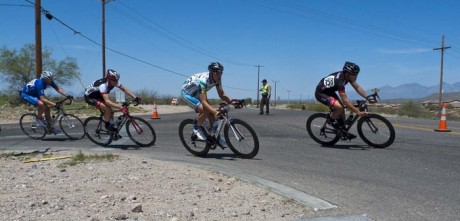
Editor’s note: Travis Woodruff is a Tucson-based cycling coach (USA Cycling certified Level I Elite Coach) and founder of Momentum Endurance, a coaching business. On Monday, Travis will begin providing bi-monthly training columns to help you take your cycling to the next level. If you would like more personalized service, contact Travis. Read more about Travis and his coaching in Tucson Velo’s Q&A.
Organizing our weekly rides so that we achieve a balance of effective training and adequate recovery is one of the biggest challenges that we face as riders looking to improve our fitness. Whether you’re training to compete or simply to keep fit it’s important to have the right mix of well-timed overload and recovery in the mix. Block training is a worthwhile option to consider if you’re looking to change up your old routine and it can also mesh well with your busy work or family schedule too.
Alternating hard and easy days is the common way to go about training and it can work well for many riders. However there are potential benefits when hard days are done consecutively, thus creating a ‘block’ of training.
By blocking two or three harder training days together it is possible to create a greater overload in a lesser amount of time, thus increasing the acute training stimulus. Another benefit is that after doing a block of hard training it allows you to take multiple days for recovery.
Consecutive days of recovery rides and/or rest days can allow for a more complete recuperation. Block training effectively amplifies the overload and also the recovery cycles. This can help you find further improvements without necessarily requiring you to increase the total time spent on the bike each week.
For many of us, weekends provide an excellent opportunity to do some faster/longer rides, often with teammates or training partners. One option for a three day block would be to do a challenging solo workout on Friday, follow it up with a fast group ride on Saturday, and then on Sunday go out for the longest of the three days with a steadier, fast pace for the duration of the ride.
After this three day block, Monday and Tuesday would be recovery days either spent off the bike or doing recovery (short/very easy pace) rides. Wednesday could then be another challenging workout while Thursday would be kept light in preparation for the next three day block.
This example would have you doing four high quality rides each week and you’d have little or no real training concerns on three of the days during your work week. Block training concentrates the workload so that you can achieve a greater overload when more training time is available and allows you to recover when training time would otherwise be most limited anyways.
Don’t be afraid to do consecutive hard days on the bike just as long as you also allow consecutive easy days to follow. Block training can be a great way to change your routine and see new benefits as a result. Give it a try and see how block training might work for you.

It would be interesting to know what Coach Woodruff thinks about velodrome training for road racing, about velodrome in general, and how he feels about Pima County’s Charles Huckleberry’s decision to build a Tucson velodrome up near Phoenix rather than within Tucson city limits. Tucson Parks and Rec, were are you?